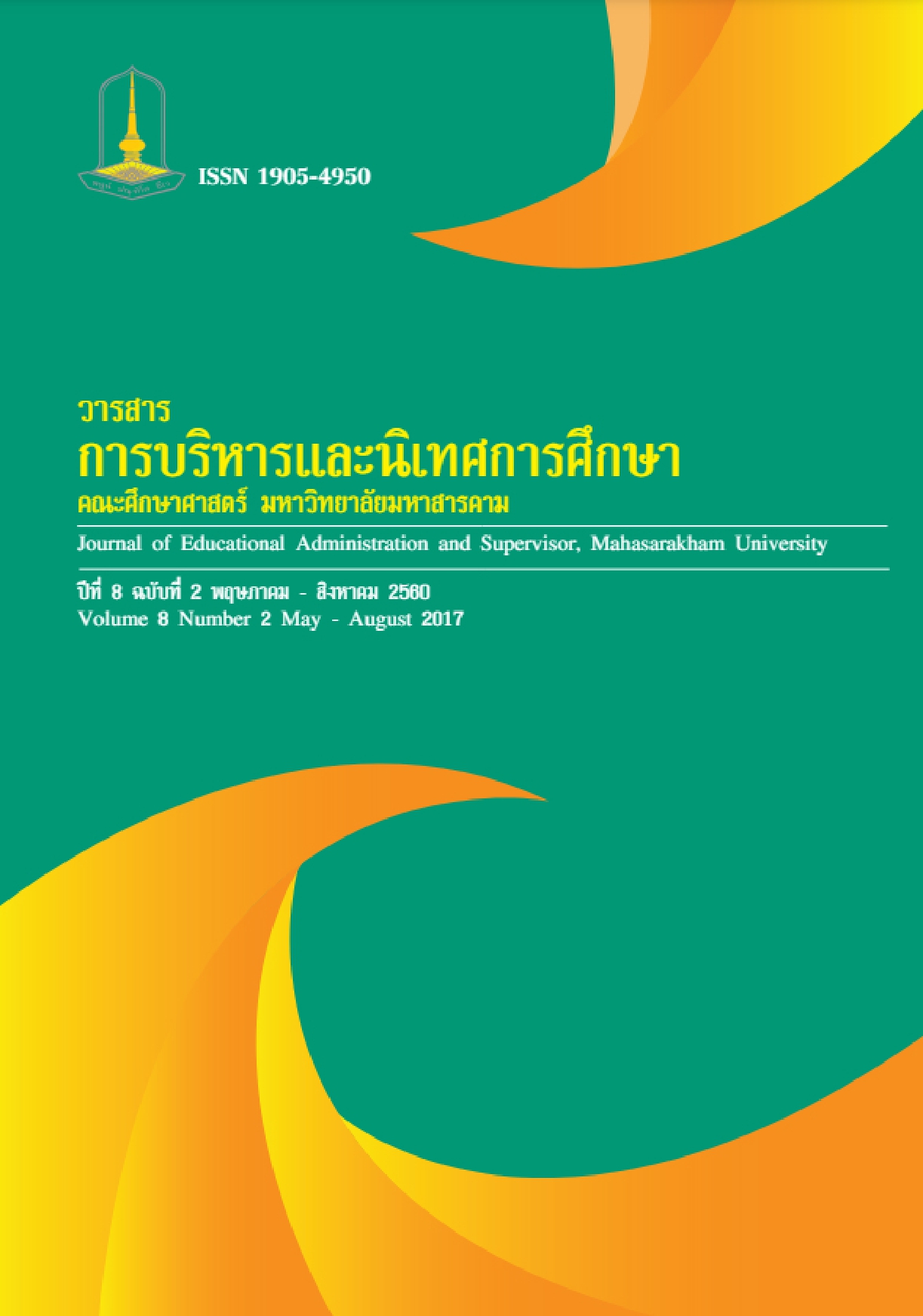การพัฒนาสื่อมัลติมีเดียโดยใช้เทคนิควิธีคิดเชาวน์ปัญญา เพื่อส่งเสริมความคิดสร้างสรรค์สำหรับนักเรียนชั้นมัธยมศึกษาปีที่ 1
Main Article Content
บทคัดย่อ
การวิจัยครั้งนี้มีวัตถุประสงค์ 1) เพื่อพัฒนาสื่อมัลติมีเดียโดยใช้เทคนิควิธีคิดเชาวน์ปัญญา เพื่อส่งเสริมความคิดสร้างสรรค์สำหรับนักเรียนชั้นมัธยมศึกษาปีที่ 1 2) เพื่อศึกษาความคิดสร้างสรรค์ของนักเรียนชั้นมัธยมศึกษาปีที่ 1 ก่อนเรียนและหลังเรียนด้วยสื่อมัลติมีเดียที่พัฒนาขึ้น 3) เพื่อศึกษาความพึงพอใจของนักเรียนหลังเรียนด้วยสื่อมัลติมีเดียที่พัฒนาขึ้น กลุ่มตัวอย่างที่ใช้ในงานวิจัยครั้งนี้ ได้แก่ นักเรียนชั้นมัธยมศึกษาปีที่ 1 โรงเรียน ซับมงคลวิทยา อำเภอเทพสถิต จังหวัดชัยภูมิ จำนวน 30 คน โดยการสุ่มแบบกลุ่ม (Cluster Random Sampling) เครื่องมือที่ใช้ในการวิจัย ได้แก่ 1) สื่อมัลติมีเดียโดยใช้เทคนิควิธีคิดเชาวน์ปัญญา 2) แบบทดสอบวัดความคิดสร้างสรรค์ของทอแรนซ์ ที่ผ่านการประเมินจากผู้เชี่ยวชาญในระดับมาก 3) แบบสอบถามความพึงพอใจของนักเรียนมีค่าความเชื่อมั่นทั้งฉบับเท่ากับ 0.87 สถิติที่ใช้ในการวิเคราะห์ข้อมูล ได้แก่ ร้อยละ ค่าเฉลี่ย และส่วนเบี่ยงเบนมาตรฐาน ผลการวิจัยพบว่า 1) สื่อมัลติมีเดียที่พัฒนาขึ้นมีองค์ประกอบ 7 องค์ประกอบ ได้แก่ (1) ตัวอักษรแบบ Lily UPC (2) ภาพฉากหลังเป็นสีโทนอ่อน (3) ตัวละครเป็นการ์ตูน 2 มิติ (4) ภาพเคลื่อนไหวเป็นแอนิเมชันผสมภาพนิ่ง (5) เสียงเป็นเสียงบรรเลง เสียงบรรยายและเสียงดนตรี (6) การปฏิสัมพันธ์ให้ผู้ใช้ควบคุมการใช้สื่อด้วยตนเอง และ (7) เนื้อหาเรื่องทัศนธาตุทางศิลปะ ซึ่งนำเสนอผ่านสื่อมัลติมีเดียด้วยเทคนิควิธีคิดเชาวน์ปัญญาที่ประกอบด้วยการแทนค่า การยืมความหมายเก่ามาใช้ใหม่ การเพิ่ม การเชื่อมโยง และความไม่เกี่ยวข้องกันเลย โดยผลการประเมินคุณภาพสื่อมัลติมีเดียจากผู้เชี่ยวชาญพบว่ามีคุณภาพในระดับมากที่สุด 2) ความคิดสร้างสรรค์ของนักเรียนชั้นมัธยมศึกษาปีที่ 1 หลังการเรียนด้วยสื่อมัลติมีเดียที่พัฒนาขึ้นสูงกว่าก่อนเรียนอย่างมีนัยสำคัญทางสถิติที่ระดับ 0.1 และ 3) นักเรียนชั้นมัธยมศึกษาปีที่ 1 มีความพึงพอใจหลังเรียนด้วย สื่อมัลติมีเดียที่พัฒนาขึ้นอยู่ในระดับมากที่สุด
Downloads
Article Details
เอกสารอ้างอิง
Anna payupat. (2015). Multimedia presentation (2nd Edition). Bangkok: OdeonStroll.
Kraisapat Varatavati. (2013). Creativity needed for 21st century education. https://www.prachachat.net/news_detail.php?newsid=1359702484.
Kanut thathong. (2011). Learning to develop thinking. Nakhon Pathom: Petchkasem Printing.
Linda Naiman. (2014). Can Creativity be Taught Results from Research Studies.http://www.creativityatwork.com/2012/03/23/can-creativity-be-taught/.
Kidanan Malithong. (2005). Educational Technology and Innovation. Bangkok: Arunkanpim Ltd.
Nattakorn Songkham. (2010). Multimedia Design and Development for Education. Bangkok: Chulalongkorn University.
Nattapon Sumathathikom. (2011). The Development of Computer Multimedia through the intemet Teaching tool for Lighting for Broadcasting Course (Undergraduate Level). Rajamangala University of Technology Phra Nakhon. Research.
Office of the Secretary of the Council for Education. (2010). Educational reform proposals in the second decade. Bangkok: Pixwah graphic limited.
Pashtun nunpakdee (2012). Graphic desing principles. Nonthaburi: IDC.
Patharapan Puyati (2015). Multimedia Electronic Model Book using Pop-up image technique for Matthayomsuksa 2 students. Thesis M.s.c (Master of science creative Media) Mahasarakham University.
Phatcharavalai Jeenanong. (2016). The Development of Multimedia for Learing on a Hundred Colred Pha Khow Ma for Level 2 Primary students. Veridian E- Journal, Silpakorn University, Thai version in Human, Arts, Social and Art Year 9 No.3 September - December 2016. https://www.tci-thaijo.org/index.p.
Rungroche huajaikal. (2016). Development of computer multimedia based on synectics method entitled solar system to enhance scientific creative thinking of Prathomsuksa 4 students. National Symposium and Research Presentation No. 3 Steps to the 2nd Decade: Integrating Research Use knowledge for sustainability June 17, 2016 at Nakhon Ratchasima College, Muang District, Nakhon Ratchasima.
Sommai Maneechote. (2015). Development of Multimedia Computer Instruction, Topic: the Ethics in the world of Information for Mathayomsuksa 5. The 1st National Conference on Technology and Innovation Management NCTIM Rajabhat Maha Sarakham University MahaSarakham Thailand 12 – 13 May 2015.
Sirote Srikomontip. (2016). The Effect of the multimedia with Classroom lnstruction to Enhance Achievement Motivation of Production Media Arts for children, Veridian E-Journal, Silpakorn University Thai version in Human, Arts, Social and Art Year 9 No.1 January - April 2016. https://www.tci-thaijo.org/index.p.
Suchart Thaothong et al. (2002). Basic Art Learning Materials Visual Art 1. 3rd Floor Bangkok: Charoen Prathet.
Supansa Khruger. (2012). The Self – Learning Multimedia on Data and Information for Matthayomsuksa 1 Students. Rajamangala University of Technology Thanyaburi. Research.
Taweesak Kanjanasawan. (2009). Multimedia technology. Bangkok KTP Com and Consultant.
Thaweesak Jindanukrak. (2015). Creativity in the science of thinking. Bangkok: Business-Dindit University
Todd Lubart. (2515). International conferences subject Assessment of the development of thinking processes. Creative analysis http://www.edsiam.com/ creativity /
Vatinee Bunjong. (2014). Effects of Organizing Art Experiences by Intergrating Design Thinking Approach on Kindergarteners’ Creativity. Chulalong University OJED, Vol.9, No.1 January - April 2014, http://www.edu.chula.ac.th./ojed.


